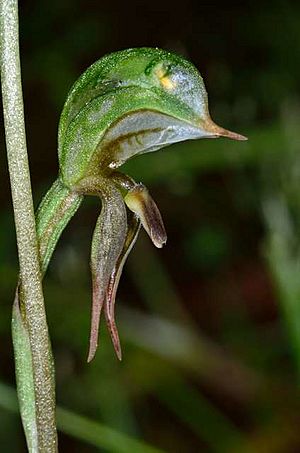Tiny rustyhood facts for kids
Quick facts for kids Tiny rustyhood |
|
|---|---|
 |
|
| Pterostylis pusilla in the Mount Remarkable National Park | |
| Scientific classification | |
| Genus: |
Pterostylis
|
| Species: |
pusilla
|
| Synonyms | |
|
Oligochaetochilus pusillus (R.S.Rogers) Szlach. |
|
The tiny rustyhood (scientific name: Pterostylis pusilla) is a special type of plant. It belongs to the amazing orchid family. You can only find this orchid in southern Australia, which means it's endemic there. This little plant has a group of leaves that grow in a circle, like a rosette. It can grow up to nine small flowers. These flowers are green and reddish-brown. They also have cool, see-through white "windows" and a dark brown part that looks like an insect. This insect-like part is called the labellum.
Contents
What Does the Tiny Rustyhood Look Like?
The tiny rustyhood is a plant that grows from an underground part called a tuber. It's a perennial plant, meaning it lives for more than two years. It's also deciduous, so its leaves fall off at certain times. This plant is a herb, which means it has soft stems, not woody ones like a tree.
It usually has three to eight leaves that form a rosette at its base. Each leaf is about 10–30 mm (0.4–1 in) long and 5–12 mm (0.2–0.5 in) wide.
When the plant flowers, it grows a stem that can be 80–250 mm (3–10 in) tall. This stem can have up to nine flowers. The flowers are green and reddish-brown with clear white parts. Each flower is about 13–16 mm (0.5–0.6 in) long and 5 mm (0.20 in) wide. The stem also has two to four leaves wrapped around its base.
Flower Parts
The top part of the flower is called the "galea." It's like a hood that covers the center of the flower. This hood is made from the dorsal (top) sepal and the petals joined together. The dorsal sepal has a narrow, upward-pointing tip about 2–3 mm (0.08–0.1 in) long.
The lateral (side) sepals point downwards. They are much thinner than the galea. Their tips are like threads, about 3–5 mm (0.1–0.2 in) long.
The labellum is a special part of the orchid flower. For the tiny rustyhood, it's quite thick and reddish-brown. It looks a bit like an insect! It's about 4 mm (0.2 in) long and 2 mm (0.08 in) wide. The "head" end of the labellum has many short hairs. There are also two to four longer hairs on each side of its "body."
This orchid usually flowers between September and October.
How It Got Its Name
The tiny rustyhood's scientific name, Pterostylis pusilla, was first officially described in 1918. A scientist named Richard Rogers gave it this name. He studied samples of the plant that were sent to him from South Australia and Victoria. He wrote about it in a scientific paper called Transactions and Proceedings of the Royal Society of South Australia.
The second part of its scientific name, pusilla, comes from a Latin word. It means "very little," "small," or "puny." This makes sense because it's a tiny orchid!
Where the Tiny Rustyhood Lives
The tiny rustyhood usually grows in places with leaf litter. You can find it in open forests or in areas with mallee scrub. It prefers stony soil.
This orchid grows in New South Wales (south of Temora), across Victoria, and in the southern parts of South Australia. These areas typically get an average of 250–600 mm (10–20 in) of rain each year.

